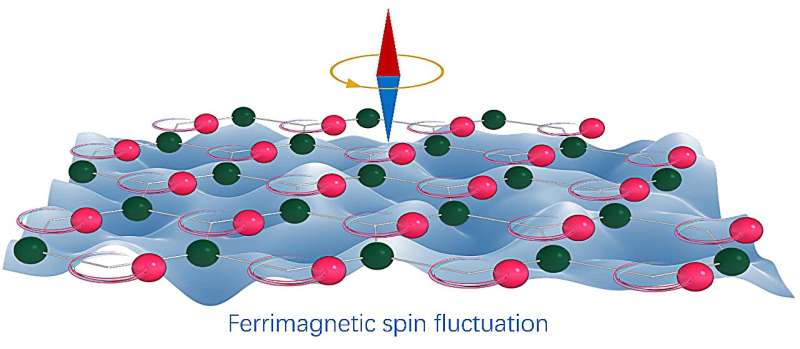New research reveals significant amplification of phonon magnetic moments in a polar antiferromagnet.

The date is October 28, 2023.
This article has been vetted following Science X's editorial guidelines. The attributes marked for approval during the check are as follows:
- fact-checked
- peer-reviewed publication
- trusted source
- proofread
Ingrid Fadelli, Phys.org, is the author.
Phonons, which are quasi-particles correlating with vibrations in a lattice or sounds, can have momentum and angular momentum. However, these quasi-particles are commonly viewed as having insignificant magnetic moments.
A research team from Nanjing University and the Chinese Academy of Sciences recently performed an experiment to investigate the phonon magnetic moments of Fe2Mo3O8, a polar antiferromagnet. The resulting work was published in Nature Physics, where they discovered significantly large phonon magnetic moments in Fe2Mo3O8, amplified by spin fluctuations.
'We were motivated to examine the magnetic properties of phonons in a spin-ordered system following recent discoveries of large phonon magnetic moments (PMM) in non-magnetic topological systems,' reported Qi Zhang, a researcher involved in the study to Phys.org. Zhang also added that broad types of spin-lattice interaction may support large PMM in magnetic materials that have not been previously identified. The roles fluctuation and many-body correlations play in the formation of PMM are still unclear.
Zhang and his team aimed to delve deeper into the relationship between phonons and magnetism. Their research revolved around running multiple experiments on the antiferromagnet Fe2Mo3O8.
Zhang articulated that large magnetic moments of phonons could forge a direct relationship between lattice vibration and various magnetic processes. This could reveal new opportunities for the management of magnetic dynamics via phononics.
In their experiments, the team used magneto-Raman spectroscopy and inelastic neutron scattering to uncover the phononic nature of a pair of low-lying excitations in Fe2Mo3O8 single crystals.
Zhang said, 'We were able to establish the phonon magnetic moments (PMM) of the modes using the phonon Zeeman effect. We observed an unusual PMM enhancement near the phase boundaries from antiferromagnetic and paramagnetic.'
The study was conducted in collaboration between Prof. Yuan Wan's team at the Chinese Academy of Sciences and Prof. Jinsheng Wen's lab at Nanjing University.
The most significant outcome of our paper was the 600% enhancement of PMM near the magnetic transition,' Zhang stated. He believes that such a fluctuation enhancement could potentially produce a PMM exceeding the magnetic moment of an electron and even diverges with magnetic susceptibility.
The team was able to detect a sixfold improvement in the phonon magnetic moment in their sample. Their work and theoretical microscopic model documenting their observations could potentially lead to new intriguing findings about the relationship between magnetism and phonons.
Zhang outlined their future plans: 'We now plan to extend this work into the non-equilibrium regime, for instance, we are interested in chiral phonons-driven magnetic dynamics or even transient ferromagnetism.' He also expressed interest in examining a phonon with a large magnetic moment to see how it behaves within a thermal transport process and if a phononic version of the spin Hall effect can occur in this system.
The journal information: Nature Physics.
Copyright 2023, Science X Network.




